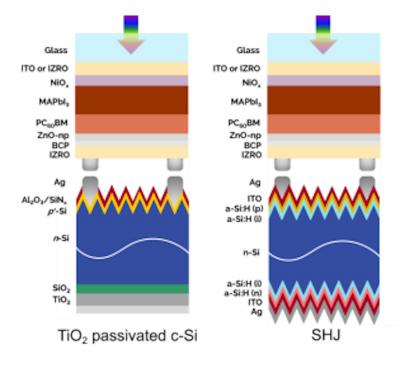Researchers from King Abdullah University of Science and Technology (KAUST) in Saudi Arabia and University of Twente in the Netherlands have developed transparent conductive films that let through a broader range of the solar spectrum, which are set to increase the power conversion efficiency of perovskite-based multijunction solar cells beyond 30%.
 A comparison of the used device test structures with different silicon bottom cells. Image taken from Advanced Functional Materials
A comparison of the used device test structures with different silicon bottom cells. Image taken from Advanced Functional Materials
Performance of perovskite-based tandem solar cells rests on the ability of the top cell to harvest the blue portion of the solar spectrum while letting through the near-infrared light. Conversely, the bottom cell only needs to absorb near-infrared light. "The semitransparency of the top cell depends on the optical bandgap and thickness of the perovskite thin film as well as the characteristics of the transparent electrodes, especially their sun-exposed side," explains study lead Stefaan De Wolf from theKAUST Solar Center.
As an alternative De Wolf, Erkan Aydin and colleagues from KAUST and the University of Twente have now fabricated transparent electrodes using zirconium-doped indium oxide (IZRO). "This material suits our perovskite-based tandem solar cells because of its distinctive properties, especially its wide bandgap exceeding 3.5 electron-volts, high conductivity and high near-infrared transparency," Aydin says.
Unlike their zirconium-free counterparts, the initially amorphous IZRO films formed large crystals when heated to 200 degrees Celsius for 25 minutes under ambient conditions, suggesting that zirconium doping promotes crystallinity. The annealed films presented higher transparency and conductivity than their untreated precursors, which directly connects crystallinity with electrode performance.
When incorporated in perovskite-silicon tandem cells, the IZRO electrodes enhanced the response of the bottom cell compared to their conventional counterparts. This increased the power conversion efficiency from 23.3% to 26.2%, "A remarkable improvement for mechanically stacked tandem solar cells," Aydin says.